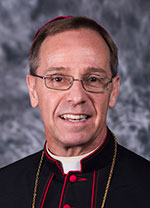Christ the Cornerstone
Good Friday, Holy Saturday prepare us for Easter joy

“The period that lasted from Thursday morning to before Easter Sunday began was once, in Anglo-Saxon times, referred to as ‘the still days.’ ” (“Holy Week,” Catholic Encyclopedia).
The publication date for this column is April 2, Friday of the Lord’s Passion (Good Friday). Today is one of the holiest days of the year. It’s a day when we remember, but more importantly relive, the suffering, abuse, crucifixion and death of our Lord and Redeemer, Jesus Christ.
We relive the Lord’s Passion today not because we are maudlin or masochistic, but because we believe that Jesus’ death is the gateway to eternal life. By his cross, we have been set free, which is why in today’s liturgy we engage in the most shocking ritual of adoration as we sing:
We adore your Cross, O Lord,
we praise and glorify your holy Resurrection,
for behold, because of the wood of a tree
joy has come to the whole world.
We celebrate this scandalous ritual—showing profound reverence for an instrument of torture and capital punishment—because we are convinced that the cross is the only way to experience the Resurrection. Only by dying can we be reborn. And only by following Jesus on the Way of the Cross can we find lasting joy.
Tomorrow (Holy Saturday) we will be in that intermediate state between death and new life that our Church celebrates by a near total silence. No Mass, no ritual activity and no music will interrupt this period of intense liturgical fasting until the Easter Vigil breaks our silence, and the Lord’s resurrection is proclaimed in the resounding tones of the Exultet.
Pope Emeritus Benedict XVI has described Holy Saturday as “a no man’s land between [Christ’s] death and resurrection.” He goes on to say that this “no man’s land” is the hell into which the Lord descended in order to transform it from a place of absolute loneliness and abandonment to a realm in which hope remains accessible to all. “In the bosom of death,” Pope Emeritus Benedict says, “life is now vibrant since love dwells within it.”
Good Friday and Holy Saturday represent the two sides of the Lord’s passion. On Friday, we relive the relentless brutality of those who mocked, tortured and crucified Jesus. On Saturday, we suffer in silence with Mary and those few—mainly women—who stood with him at the foot of the cross. Friday is a day of intense anguish, of suffering with the Lord of Life. Saturday is a day of quiet mourning, of sharing in the sorrows of those who loved him best.
A few weeks ago, reflecting on the readings for the Second Sunday of Lent, I wrote:
In our contemporary culture, we tend to forget that there is an essential connection between “love” and “sacrifice.” To really love someone else, we must be prepared to make sacrifices, to give up our own needs and desires for the sake of another. … Sacrifice and love go hand in hand. There is no such thing as selfish or self-centered love in spite of what we are told by our culture. Love means letting go of our own desires for the good of others. It means making sacrifices for the greater good.
This fundamental truth—the inseparable connection between sacrifice and love—is what we celebrate in the Easter Triduum. We relive the Lord’s passion and death in order to experience for ourselves the liberating power of a love that is completely selfless.
We adore the wood of the cross because Christ’s death has transformed it from a thing of horror to a symbol of hope. We descend into the hell with Jesus in order to witness firsthand how his light overcomes all darkness. We stand with Mary and Jesus’ closest supporters at the foot of the cross, and we weep with them as his body rests in the silence of the Holy Sepulcher until we are ready to proclaim to the whole world that the Lord is risen!
In Anglo-Saxon times, the period between Holy Thursday and the Easter Vigil was known as “the still days.” In a way, the world and its frenetic activity are put on hold during this time of intense remembrance. We stand still during this holy time because we want to make sure that we can savor both the bitter and the sweet moments of this sacred remembrance. To rush through our observance of “the still days” would mean that we really don’t understand how love and sacrifice are connected. It would mean that we have missed one of the most important truths of Christian faith and practice.
Today and tomorrow, let’s put our busy lives on hold long enough to relive the sacrificial love of Jesus and the joy that can only come from unselfish love. †
